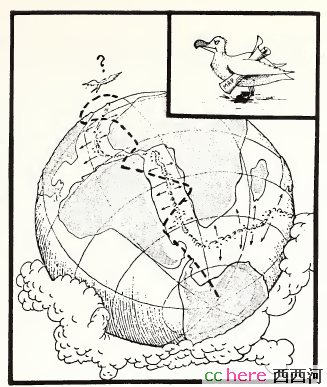主题:一个人和一个完整世界 -- 郭十一
一块有花纹的蜡饼,加热至高温,在液态一切花纹不复存在。
(磁性特征类似花纹,磁铁加热升温至居里点后磁性丧失,类似花纹消失)
而当它慢慢冷却时,压一块模板上去,就可以形成纹样。
而当它完全冷却变硬之后,你再压一块模板上去,原有的纹样也不会改变。
当然,力道要在一定范围内。
而从地磁学家的处理来看,地磁场施加于岩石的力道应在这个范围内。
也可能是 Manx shearwater(普通鹱),都是长距离候鸟。
此外1948年Science也有篇文章讲这个的,里面提到了另三种鸟,arenaria interpres翻石鹬,crocethia alba三趾鹬,和calidris canutus漂鹬
-"Bird Migration and the Concept of Continental Drift",Albert Wolfson, Science 9 July 1948: 23-30
Wolfson的文章讲的是别的内容,他的主要例子是
Arctic tern,中文好像叫北极燕鸥。
他的主要观点是强调远程飞行能力在进化选择中的重要性。
没有读到他的原文,但可以明确的是,他关心的是远-近对比,而不是曲-直。
古狗“海洋鹱”有14个记录, 基本上都是同一个来源,也就是你说的那个。 而且找不到英文名字。
下面链接里面提供的英文名字则是错误的。
http://mall.cnki.net/magazine/Article/DIQU199604002.htm
"洋骥(octanicng)为了它们在长白昼极地过愉快的生活,它们世世代代总是从南极到北极反复迁徙,当它们到斯匹次卑尔根群岛时恰恰是4月,在这里开始繁衍生息。"
百度百科-鹱科下面没有海洋鹱这一类。
http://baike.baidu.com/view/129553.htm
Wiki百科Procellariidae一条下面则没有提到鹱科鸟类下面某种鸟有这种特异的迁徙行为。所以也无从知道所谓海洋鹱到底是哪一种鸟。
https://en.wikipedia.org/wiki/Procellariidae
这个页面里面还提到鹱科鸟类的DNA研究表明他们的分化始于3千万年以前,那时各大陆已经分得很开了。
如果鹱科鸟类的很久很久前的共同祖先(久远到甚至可能也是其他科鸟类的祖先)记得住如此久远之前的地形地貌的话,很难解释为何只有一种后裔忠实的循这个路线前进。
据我查到的摘要,他们文中称为海洋鸌(PUFFINUS OCEANICUS),这个名字有点问题,但还不清楚是原作者的问题,还是录入员的问题,如你所知,那个链接的octanicng应是录入错误。
有谁能把原文下载一下就好了。
从查询结果来看,这是两个中国学者77年的发现,在国际上基本没有影响。
但这并不能说明是编出来的,一方面那时中国与外面的世界联系不多,可能不被注意,另一方面,后面交流多了,但大陆漂移早已不是热点,难以进入视野。有人为大陆漂移方面的争议写了4卷The Continental Drift Controversy,要卖几百美刀。
可见,这方面的文献实在多得读不过来,很难再注意到两个中国学者在科普杂志上公布的
观点。
我的看法是,读到原文,确定名称,在西文文献中查找其迁移路线,确定几个转折点在原始大陆上的位置,然后我们才可以判断这个说法是否成立,
在此之前说是编出来有点草率。
看十一兄的解释,是石头形成初期受磁场影响。
没什么大了不起的发现,不过有个地方在括号里面写上了"sooty hoodwink", (Implications of Continental Drift to the Earth Sciences ... - jstor
www.jstor.org/stable/2412912
"new evidence [that] came in from an entirely unexpected quarter-the animal kingdom" (p. 1106): Puffinus oceanicus (the sooty hoodwink),. Glossostompodon.)
再搜索"sooty hoodwink"就有意思了,你可以看看下面这个。
http://www.minersoc.org/pages/Archive-MM/Volume_41/41-317-137.pdf
第138页
Other major discoveries of recent years are treated in an anecdotal fashion, including the evidence for desiccation of the Mediterranean during the Miocene, and the identification of Minoan Crete as 'lost Atlantis', destroyed by the eruption of the island of Santorini. The serious theme of the book is further lightened by the humour the plate tectonics hypothesis
seems to have inspired among Earth Scientists, including the Plate tectonics version of the Nicene Creed. Also the unlikely tale of the migrations of the sooty hoodwink (Oceanites erraticus), which once flew a longitudinal course from the Antarctic Peninsula to Spitzbergen across the site of the future Atlantic but developed an increasingly zig-zag course as the Atlantic opened beneath it.
这是对下面这本书的评价。
Wyllie (P. J.). The way the Earth works: An introduction to the new Global Geology and its revolutionary development. New York and London (John Wiley & Sons), 1976. viii+z96 pp.,
I34 figs. Price: cloth s ($I5.9o), paper s ($8.oo).
鉴于这本书作于1976年,我们不妨说那两位中国学者并非独立的,第一次提出这个观点,而是在转介国外学者的观点。这观点能不能站住脚是另外一回事。
又,这本书似乎比较有名,有中文翻译。信息如下:
P.J.怀利著,张崇寿等译:《地球是怎样活动的》,地质出版社,北京,1980。(P.J.Wyllie,The Way the Earth Works,John Wiley & Sons,New York,1976.
本来我没说出来的话是,在这两个中国学者身上看到的想象力是我们传统上比较陌生的。
也许从思想传统的角度来看,在我们这里,有想象力的成果的缺乏比有深度的成果的缺乏
更为严重,所以这个观点的提出值得赞许。
但现在,又另当别论了。
Puffinus本身就是指的一类(包含二十多种)中型(以及少数大型)鹱类海鸟,在后面再加个Oceanicus实际上意义有点重复了,更像是某些研究者取的命名,可能并未取得广泛承认而后就取消使用了。而其首先提出者原来指的到底是Puffinus中的哪一种,恐怕只有结合前后文才能知道。附列表(来自wiki):
中型的:
Christmas shearwater, Puffinus nativitatis
Manx shearwater, Puffinus puffinus
Yelkouan shearwater, Puffinus yelkouan
Balearic shearwater, Puffinus mauretanicus
Bryan's shearwater, Puffinus bryani
Black-vented shearwater, Puffinus opisthomelas
Townsend's shearwater, Puffinus auricularis
Newell's shearwater, Puffinus newelli
Rapa shearwater, Puffinus myrtae
Fluttering shearwater, Puffinus gavia
Hutton's shearwater, Puffinus huttoni
Audubon's shearwater, Puffinus lherminieri
Persian shearwater, Puffinus persicus
Tropical/Baillon's shearwater, Puffinus bailloni
Galápagos shearwater, Puffinus subalaris
Bannerman's shearwater, Puffinus bannermani
Heinroth's shearwater, Puffinus heinrothi
Little shearwater, Puffinus assimilis
Barolo shearwater, Puffinus baroli
大型一些的:
Boyd's shearwater, Puffinus boydi
Wedge-tailed shearwater or muttonbird (Northern and western Australia), Puffinus pacificus
Buller's shearwater, Puffinus bulleri
Sooty shearwater or muttonbird (New Zealand), Puffinus griseus
Short-tailed shearwater or muttonbird (Southern Australia), Puffinus tenuirostris
Pink-footed shearwater, Puffinus creatopus
Flesh-footed shearwater, Puffinus carneipes
Great shearwater, Puffinus gravis
The Animals Remember
All was not lost, however, for new evidence came in from an entirely unexpected
quarter — the animal kingdom. Animals have some remarkably developed instincts,
which sometimes recapitulate their evolutionary history. Witness the so-called loud
bats with their FM sonar chirps by which they can search out and classify a moving
target — usually moths, their favourite meal. But it remained for a bird, by its remark-
able migratory path, to first demonstrate that the New World really has drifted away
from the Old World.
This doughty bird, the sooty hoodwink, Puffinus oceanicus, winters in the Atlantic
sector of Antarctica; then each spring it heads north, determined to nest in far away
Spitzbergen. As if flying to this remote island is not a sufficient demonstration of
fortitude, this bird chooses a zigzag path. First it touches down in Southwest Africa
where, because of its confused and dazed habit of stumbling about (apparently
searching for fresh bearings), it is locally termed the random walkabout. Then this
bird executes further zigs and zags across the ocean as it threads its way north. On
April 1st, the frayed remnants of the flock touch down on the British Isles at Lands
End. (Remarkable as it is, their navigation sometimes goes awry. An errant flock was
seen in 1967 far off course in the spaghetti fields of the Po valley.) Toward the end of
April the sooty hoodwink finally reaches its destination, Spitzbergen.
This curious migration path finds ready explanation once we recognize that
continental drift has occurred. If we close the Atlantic Ocean, we find that the zigzag
path becomes a straight line, a great circle route, or the shortest distance between
Antarctica and Spitzbergen.


出处:
Collected reprints / Atlantic Oceanographic and Meteorological Laboratories [and] Pacific Oceanographic Laboratories
注:
这个例子出自这本书中的
Continents Adrift: New Orthodoxy or Persuasive Joker?
作者显然对大陆漂移说持嘲讽态度。
但文中没有看到来源说明。
原来的想法是想当然说的,(因为毕竟地磁科学家这么做了)
刚才又去读了下,应该更正如下。
沿用原来的比方,当你再放一块模板上去,会造成较浅的花纹,有办法
抹除,恢复第一块模板压出的花纹,进而获知第一块模板的形状(对模板来来说,花纹就是简单的反像,对地磁场来说,一块岩石的磁化特征应是磁子午线上的一个点)
详情请查维基百科。
rock magnetism
迪茨1972年11月在地质时报(geotimes)的通讯中提出了这个观点,
楼上
所以我才飞好远的英文资料,配图
一帖中的
配图就是出自这篇通讯,是他的同事霍尔登画的。
Robert Sinclair Dietz (September 14, 1914 – May 19, 1995) was a scientist with the US Coast and Geodetic Survey.
He received the Walter H. Bucher Medal from the American Geophysical Union in 1971, the Barringer Medal from the Meteoritical Society in 1985 and the Penrose Medal from the Geological Society of America in 1988.
在Arizona 州还有一座以他名字命名的博物馆。
看来,不能以文青视之。
这个原始出处里的配图让人很困惑阿。 以第二图和文字为基准,从南极洲出来第一站应该是非洲西南。但第一图里显示是在南美。
还有这鸟既然依靠地貌飞行,那它离开大陆进入海洋后方向应该保持在大陆上最后一段的方向,然后再次进入大陆时的点无论从几何学还是附图上都很难再是古大陆直线上的一点。接下来它不该就晕头转向了么?
除非大陆-海洋-大陆这一段它们是按点对点飞的,方向在长期的漂移中被扭曲了。那它们在海上这段时间又怎么不依赖地貌保持方向的呢? 记忆的是路径点,那就要求它们多年来栖息点从来不变,哪怕相邻点之间的飞行时间从一天被拉长成几天。而点与点之间飞行的导航却是按方向,这鸟好别扭。
感觉好多细节都缺少,不知道学术上这是作为一个定论还是假说,不过作为科普倒是好有意思的。 赞。